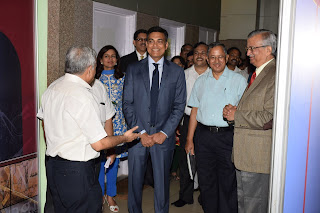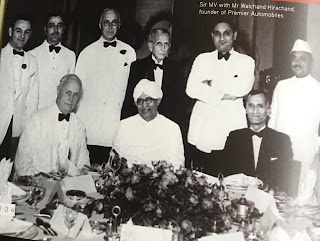Battle of Gallipoli - An Entente Most Remarkable : Remembering the contribution of Indian troops in this Battle
April 25, 2020, marks the 105th anniversary of the historic landing of the allied troops the ANZAC (Australian and New Zealand) on the Gallipoli Peninsula, for one of the most treacherous military campaign in the worst of battle conditions in the trenches of death, during WW1. This battle is now legendary and several heroic stories, books, documentaries and films have been told about this battle, which lasted eight months and claimed at least 125,000 lives. Most unfortunately for nearly 100 years since this battle, not much was known about the participation of Indian soldiers in this battle, let alone chronicling their contributions to the battle. Fortunately the vital contributions of Indian soldiers in this battle caught the attention of a well known Australian historian and researcher Prof Peter Stanley, who through his intensive research has changed all that and documented, with extraordinary details, the contributions of Indian soldiers in the Battle of Gallipoli in his book “Die in Battle, Do not Despair, The Indians on Gallipoli 1915”.
While curating an exhibition ‘Cricket Connects : India - Australia Cricket Relations’, as a part of the ‘Confluence : Festival of India in Australia’, which was presented at the historic Sydney Cricket Grounds, in October 2016, I had an opportunity to connect this historicity of relation between the two countries in one of the sections in the exhibition. It was heartening to note that of all the ten sections of the exhibition this part of the exhibition evoked an extraordinary emotional feeling and connect for most Australian visitors to the exhibition.
The Indian troops, who fought shoulder to shoulder with their other compatriots of the ANZAC, which consisted of soldiers from Australia, Great Britain, Ireland, France, India, and Newfoundland, comprised of Gurkha and Sikh battalions and innumerable mule drivers who literally transported British forces and their allies. The ANZACs landed on the Gallipoli peninsula on the 25th April 1915 and fought in the trenches and on the frontline and in the process thousands perished and several thousand more were either wounded or scarred for life. The Australians, New Zealanders and Indian soldiers united fight during this epic battle is something that would not have been countenanced in a “White Australia” during this period.
The Gallipoli Campaign, also known as the Dardanelles Campaign, the Battle of Gallipoli or the Battle of Çanakkale (Turkish: Çanakkale Savaşı), was a British campaign of World War I fought with the aim of capturing the Ottoman capital of Constantinople (modern day Istanbul). This battle may have been a defeat for the ANZAC, if one looks prismatically with the objectives with which this battle was fought - to push out the Ottoman Empire and to create a new front for the allied forces. However a look at the historical war records and casualty data from World War, reveals and clearly demonstrates the Gallipolis campaign value to the Allied cause. The New Zealand government’s historical record documents that the Allies (which included Australians, British, Canadians from Newfoundland, French, Irish, Indians and New Zealanders) sustained 1,41,547 casualties (dead, wounded and missing) at Gallipoli – among those numbers were 44,150 dead. The Ottoman Empire forces sustained a far higher casualties - 2,51,309 including an astonishing 86,692 dead. The casualties on the enemy side almost doubled the ANZACs numbers including the dead and what is more revealing is that the Ottoman forces were strategically at a more vantage position than the ANZAC forces. Looking at the ratio – dividing the impact on the Ottoman side by the input of Allied force casualties – one can notice that the Allied soldiers were relentless in their heroic gallantry and displayed incredible valour, courage and endurance in the most hostile environment in which this battle was fought.
The valour with which the Allied forces fought this dreaded Gallipoli battle has led to the ANZAC legend that continues to live on to be celebrated and revered both in Australia and New Zealand, every year.
The ANZAC legend is celebrated as the Anzac Day on April 25, marking the landing of Anzac at Gallipoli in 1915. Every year, there are ceremonial marches and parades in most Australian and New Zealand cities to mark the sacrifice of those who lost their lives in the line of duty. The Sikh community, who fought alongside the Australians, has proudly joined in this tradition of paying homage to their forefathers and since 2005, there has been a Sikh contingent in the Anzac Day march in Perth, Australia, comprised of direct descendants of those who fell in Gallipoli and other campaigns.
The Gallipoli battle records have revealed the respect that the Australian soldiers had for the Indian soldiers, which is evidenced in one of the statement; “The [Indians] batteries did so well and gallantly that the Australians have metaphorically taken them to their hearts. All are the greatest pals imaginable, and the political effect of this cordial friendship should be good for both India and Australia.” Most unfortunately, we Indians have forgotten to respect our battle warriors who perished in this epic battle. Through this post, on behalf of my countrymen ( women included) I wish to pay our respect and reverence to those British Indian soldiers who perished not only in this battle but also in both the WWI and WWII.
The best tribute for the battle heroes, the brave ANZAC, who were martyred during the WWI at Gallipoli, can be witnessed in the words of Mustafa Kemal Atatürk (1881-1938), an army officer who was part of this battle and who founded an independent Republic of Turkey out of the ruins of the Ottoman Empire. He served as Turkey's first president from 1923 until his death in 1938.
“Those heroes that shed their blood and lost their lives; you are now lying in the soil of a friendly country. Therefore rest in peace. There is no difference between the Johnnies and the Mehmets to us where they lie side by side here in this country of ours. You, the mothers, who sent their sons from far away countries, wipe away your tears; your sons are now lying in our bosom and are in peace. After having lost their lives on this land they have become our sons as well” Mustafa Kemal Atatürk
May the revered souls of valiant soldiers, who fought for our country, continue to rest in eternal peace in the heavenly abode which is home to them.
Jai Hind.



























































